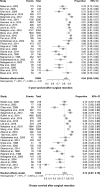Prognostic factors for overall survival after surgical resection in patients with thymic epithelial tumors: A systematic review and meta-analysis
- PMID: 36181069
- PMCID: PMC9524934
- DOI: 10.1097/MD.0000000000030867
Prognostic factors for overall survival after surgical resection in patients with thymic epithelial tumors: A systematic review and meta-analysis
Abstract
Background: Thymic epithelial tumors (TETs) originate in the thymic epithelial cell, including thymoma and thymic carcinoma. Surgical resection is the first choice for most patients. However, some studies have shown that the factors affecting the prognosis of these patients are not consistent. To evaluate prognostic factors in patients with surgically resected thymic epithelial tumors, we performed a meta-analysis.
Methods: We searched the Chinese biomedical literature database, Pubmed, Embase, Cochrane Library and other electronic databases. Studies including postoperative overall survival (OS) and predictors of TETs were included. We made a comprehensive analysis the hazard ratios (HRs) through a single proportional combination. HRs were combined using single proportion combinations.
Results: The meta-analysis included 11,695 patients from 26 studies. The pooled OS was 84% at 5 years and 73% at 10 years after TETs operation. The age as continuous-year (HR 1.04, 95% confidence interval (CI) 1.02-1.04), incomplete resection (HR 4.41, 95% CI 3.32-5.85), WHO histologic classification (B2/B3 vs A/AB/B1 HR 2.76, 95% CI 1.25-6.21), Masaoka Stage (stage III/IV vs I/II HR 2.74, 95% CI 2.12-3.55,) were the poor prognostic factors.
Conclusions: For patients with TETs after surgical resection, advanced age, incomplete resection, WHO classification B2/B3, and higher Masaoka stage are risk factors for poor prognosis.
Copyright © 2022 the Author(s). Published by Wolters Kluwer Health, Inc.
Conflict of interest statement
The authors have no conflicts of interest to disclose.
Figures



References
-
- Marx A, Ströbel P, Badve SS, et al. . ITMIG consensus statement on the use of the WHO histological classification of thymoma and thymic carcinoma: refined definitions, histological criteria, and reporting. J Thorac Oncol. 2014;9:596–611. - PubMed
-
- Engels EA, Pfeiffer RM. Malignant thymoma in the United States: demographic patterns in incidence and associations with subsequent malignancies. Int J Cancer. 2003;105:546–51. - PubMed
-
- Gatta G, van der Zwan JM, Casali PG, et al. . Rare cancers are not so rare: the rare cancer burden in Europe. Eur J Cancer. 2011;47:2493–511. - PubMed
-
- Conforti F, Pala L, Giaccone G, et al. . Thymic epithelial tumors: from biology to treatment. Cancer Treat Rev. 2020;86:102014. - PubMed
Publication types
MeSH terms
Supplementary concepts
LinkOut - more resources
Full Text Sources
Medical

